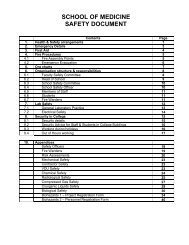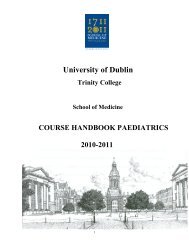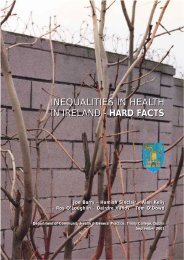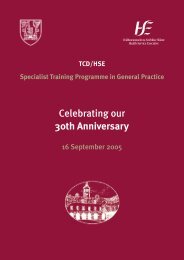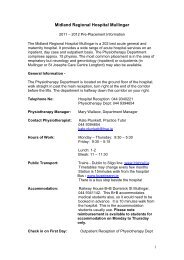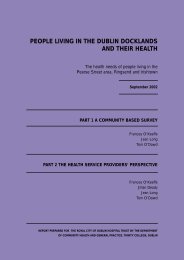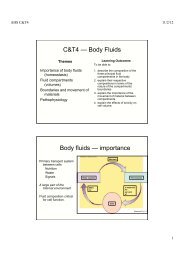people living in finglas and their health - School of Medicine - Trinity ...
people living in finglas and their health - School of Medicine - Trinity ...
people living in finglas and their health - School of Medicine - Trinity ...
You also want an ePaper? Increase the reach of your titles
YUMPU automatically turns print PDFs into web optimized ePapers that Google loves.
LIST OF TABLES Page LIST OF TABLES<br />
Page<br />
Table 2.1<br />
Distribution <strong>of</strong> sample <strong>and</strong> population <strong>in</strong> both high <strong>and</strong> low deprivation district<br />
electoral divisions <strong>in</strong> F<strong>in</strong>glas<br />
15<br />
Table 3.23 Primary carers’ reported purpose for most recent use <strong>of</strong> the general practitioner by<br />
<strong>in</strong>dividuals <strong>in</strong> <strong>their</strong> household <strong>in</strong> the 12 months prior to the survey<br />
46<br />
Table 3.1<br />
Table 3.2<br />
Primary carers’ reported characteristics <strong>of</strong> <strong>their</strong> households<br />
Primary carers’ reported access to communication, heat<strong>in</strong>g <strong>and</strong> <strong>health</strong> cover<br />
22<br />
23<br />
Table 3.24 Primary carers’ reported number (%) <strong>of</strong> the <strong>in</strong>dividuals who visited <strong>their</strong> GP <strong>in</strong> the<br />
year prior to the survey, <strong>their</strong> level <strong>of</strong> satisfaction with services <strong>and</strong> <strong>their</strong> reasons for<br />
satisfaction/dissatisfaction<br />
47<br />
Table 3.3<br />
Demographic <strong>and</strong> socio-economic characteristics <strong>of</strong> the primary carer<br />
24<br />
Table 3.25 Primary carers’ reported use <strong>of</strong> <strong>and</strong> satisfaction with ‘out <strong>of</strong> hours’ medical services<br />
48<br />
Table 3.4<br />
Table 3.5<br />
Table 3.6<br />
Table 3.7<br />
Table 3.8<br />
Table 3.9<br />
Primary carers’ reported demographic, family <strong>and</strong> socio-economic <strong>in</strong>formation for<br />
<strong>in</strong>dividuals resid<strong>in</strong>g <strong>in</strong> the households<br />
Primary carers’ reported tobacco use <strong>and</strong> (alcohol or illicit) drug dependency<br />
<strong>in</strong> the households<br />
Primary carers’ reported number (%) <strong>of</strong> <strong>in</strong>dividuals (18 years or older) <strong>in</strong> the<br />
households who smoke <strong>and</strong> the quantity smoked each day by these <strong>in</strong>dividuals<br />
Primary carers’ reported number (%) <strong>of</strong> <strong>in</strong>dividuals <strong>in</strong> <strong>their</strong> households with a<br />
drug/alcohol problem <strong>and</strong> also <strong>their</strong> <strong>health</strong> service uptake<br />
Primary carers’ reported experience <strong>of</strong> stress<br />
Primary carers’ reported experience <strong>of</strong> <strong>in</strong>timidation <strong>and</strong>/or violence <strong>in</strong><br />
the last 12 months<br />
25<br />
26<br />
26<br />
27<br />
28<br />
30<br />
Table 3.26 Logistic regression model to identify determ<strong>in</strong>ants <strong>of</strong> attend<strong>in</strong>g a general practitioner<br />
as one <strong>of</strong> the last three <strong>health</strong> services used <strong>in</strong> the year prior to the survey among the<br />
F<strong>in</strong>glas population (563/963)<br />
Table 3.27 Primary carers’ reported vacc<strong>in</strong>ation uptake for children aged between two <strong>and</strong> five<br />
years resid<strong>in</strong>g <strong>in</strong> <strong>their</strong> households<br />
Table 3.28 Primary carers’ reported number (%) <strong>of</strong> the <strong>in</strong>dividuals seen by the community<br />
nurs<strong>in</strong>g service <strong>in</strong> the year prior to the survey, <strong>and</strong> <strong>their</strong> level <strong>of</strong> satisfaction with services<br />
Table 3.29 Primary carers’ distance from pharmacy services <strong>and</strong> <strong>their</strong> level <strong>of</strong> satisfaction with<br />
<strong>their</strong> usual pharmacy<br />
Table 3.30 Primary carers’ reported number (%) <strong>of</strong> the <strong>in</strong>dividuals who visited <strong>their</strong> dentist <strong>in</strong> the<br />
year prior to the survey, <strong>their</strong> level <strong>of</strong> satisfaction with services <strong>and</strong> <strong>their</strong> reasons for<br />
satisfaction/dissatisfaction<br />
49<br />
50<br />
51<br />
51<br />
52<br />
Table 3.10 Primary carers’ reported experience <strong>of</strong> cop<strong>in</strong>g with teenage children <strong>and</strong> the type<br />
<strong>of</strong> assistance sought<br />
Table 3.11 Primary carers’ reported numbers (%) with a chronic illness<br />
Table 3.12 Primary carers’ reported types <strong>of</strong> chronic illness, the level <strong>of</strong> care required<br />
<strong>and</strong> <strong>health</strong> services used by <strong>in</strong>dividuals resid<strong>in</strong>g <strong>in</strong> <strong>their</strong> households<br />
Table 3.13 Logistic regression model to identify factors associated with hav<strong>in</strong>g a chronic illness<br />
<strong>in</strong> the F<strong>in</strong>glas population (291/963)<br />
31<br />
32<br />
33<br />
34<br />
Table 3.31 Primary carers’ reported numbers (%) wait<strong>in</strong>g for <strong>health</strong> care<br />
Table 3.32 Primary carers’ reported number (%) <strong>of</strong> the <strong>in</strong>dividuals resid<strong>in</strong>g <strong>in</strong> the households<br />
wait<strong>in</strong>g for <strong>health</strong> care, length wait<strong>in</strong>g for service, location <strong>of</strong> service <strong>and</strong> satisfaction<br />
with wait<strong>in</strong>g period<br />
Table 3.33 Logistic regression model to identify determ<strong>in</strong>ants <strong>of</strong> those wait<strong>in</strong>g for <strong>health</strong> care <strong>in</strong><br />
the F<strong>in</strong>glas population (63/963)<br />
Table 3.34 Primary carers’ reported sources <strong>of</strong> <strong>in</strong>formation on <strong>health</strong> (n=324)<br />
53<br />
53<br />
54<br />
55<br />
Table 3.14 Primary carers’ reported numbers (%) with disability<br />
35<br />
Table 3.35 Additional <strong>health</strong> care services suggested by primary carers<br />
56<br />
Table 3.15 Primary carers’ reported types <strong>of</strong> disability, the level <strong>of</strong> care required<br />
<strong>and</strong> <strong>health</strong> services used by <strong>in</strong>dividuals resid<strong>in</strong>g <strong>in</strong> <strong>their</strong> households<br />
36<br />
Table 3.16 Logistic regression model to identify factors associated with hav<strong>in</strong>g a disability <strong>in</strong> the<br />
F<strong>in</strong>glas population (40/963)<br />
37<br />
Table 3.17 Primary carers’ reported numbers (%) who attended the hospital<br />
38<br />
Table 3.18 Primary carers’ reported type <strong>of</strong> appo<strong>in</strong>tment for, channel <strong>of</strong> referral to <strong>and</strong> means<br />
<strong>of</strong> transport used by <strong>in</strong>dividuals <strong>in</strong> <strong>their</strong> households to attend a hospital service <strong>in</strong> the<br />
12 months prior to the survey<br />
39<br />
Table 3.19 Logistic regression model to identify the factors that <strong>in</strong>fluenced use <strong>of</strong> a hospital<br />
service <strong>in</strong> the year prior to the study among the F<strong>in</strong>glas population (324/963)<br />
40<br />
Table 3.20 Primary carers’ reported current use <strong>of</strong> family plann<strong>in</strong>g, recent uptake <strong>of</strong> cervical<br />
smear tests <strong>and</strong> breast exam<strong>in</strong>ation<br />
43<br />
Table 3.21 Primary carers’ reported number <strong>of</strong> pregnancies <strong>in</strong> <strong>their</strong> households between<br />
January 1997 <strong>and</strong> April 2002, as well as <strong>health</strong> practices <strong>and</strong> service uptake by<br />
pregnant women for the most recent pregnancy<br />
44<br />
Table 3.22 Primary carers’ reported number (%) <strong>of</strong> the <strong>in</strong>dividuals admitted to maternity hospital<br />
<strong>in</strong> the year prior to the survey, <strong>and</strong> the level <strong>of</strong> satisfaction with services<br />
.<br />
45<br />
6<br />
7






